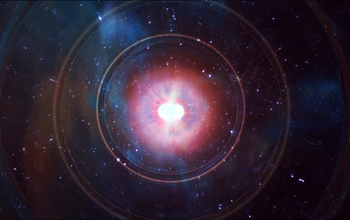Multimedia Gallery
Gravitational waves emitted when superdense neutron stars collide
Artist's impression of the explosion and burst of gravitational waves emitted when a pair of superdense neutron stars collide. New observations with radio telescopes show that such events can be used to measure the expansion rate of the universe.
Astronomers used the National Science Foundation's Very Long Baseline Array, the Karl G. Jansky Very Large Array and the Robert C. Byrd Green Bank Telescope to make these observations.
Learn more about this research in the National Radio Astronomy Observatory news story New method may resolve difficulty in measuring universe’s expansion. (Date image taken: unknown; date originally posted to NSF Multimedia Gallery: Oct. 2, 2019)
Credit: NRAO/AUI/National Science Foundation
Images and other media in the National Science Foundation Multimedia Gallery are available for use in print and electronic material by NSF employees, members of the media, university staff, teachers and the general public. All media in the gallery are intended for personal, educational and nonprofit/non-commercial use only.
Images credited to the National Science Foundation, a federal agency, are in the public domain. The images were created by employees of the United States Government as part of their official duties or prepared by contractors as "works for hire" for NSF. You may freely use NSF-credited images and, at your discretion, credit NSF with a "Courtesy: National Science Foundation" notation.
Additional information about general usage can be found in Conditions.
Also Available:
Download the high-resolution JPG version of the image. (714.0 KB)
Use your mouse to right-click (Mac users may need to Ctrl-click) the link above and choose the option that will save the file or target to your computer.



